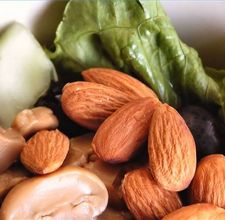Posts Tagged: Vitamin
 Vitamin D is a fat-soluble vitamin needed in bone formation, insulin regulation, muscle function, immune health, and the balance of phosphorus and calcium in the body. Adults should take in 600 IU of vitamin D every day.
Vitamin D is a fat-soluble vitamin needed in bone formation, insulin regulation, muscle function, immune health, and the balance of phosphorus and calcium in the body. Adults should take in 600 IU of vitamin D every day.
Eat foods rich in vitamin D, such as shrimp, eggs and salmon.
Because natural food sources of vitamin D are rare, choose fortified versions of orange juice, butter substitute, yogurts, cereals and milk.
Magnesium, vitamin A, vitamin K, zinc and boron are all necessary to bring up levels of vitamin D. Magnesium has the greatest effect on vitamin D, so include nuts, beans and fish in yours daily diet.
Spend about 15-20 minutes of sun exposure daily can prevent vitamin D deficiency in most people. Those with darker skin tones might require more time in the sun.
Take a vitamin D supplement if your food sources of vitamin are insufficient or if you are unable to spend time outdoors.
Consult your doctor or pharmacist about medications that may interfere with your body’s ability to absorb or use vitamin D. eg. Anticonvulsants, corticosteroids, hormone replacement drugs, and anticoagulants.
Vitamin D3 supplements are better metabolized than other forms of vitamin D.
 The omega-3 fatty acids play an important role in keeping the heart, kidneys, and digestive system healthy. The body needs omega-3 fatty acids to make prostaglandins that regulate blood clotting, hormone production, and inflammation, pain, and swelling in the body. There is no Recommended Dietary Allowance (RDA) for omega-3 fatty acids, but you should try to get one gram a day.  Nutritionists generally recommend eating cold-water fish 2 to 3 times a week; the oilier the fish, the more omega-3 it has.
The omega-3 fatty acids play an important role in keeping the heart, kidneys, and digestive system healthy. The body needs omega-3 fatty acids to make prostaglandins that regulate blood clotting, hormone production, and inflammation, pain, and swelling in the body. There is no Recommended Dietary Allowance (RDA) for omega-3 fatty acids, but you should try to get one gram a day.  Nutritionists generally recommend eating cold-water fish 2 to 3 times a week; the oilier the fish, the more omega-3 it has.
Â
Samples of fish with omega-3 fatty acids:
Salmon, Atlantic 3.1-3.7 grams per 6 oz cooked serving
Sardines, packed in oil 2.8 grams per 3 oz serving
Salmon, Coho 1.8-2.2 grams per 6 oz cooked serving
Herring, Kippered 1.8 grams per 3 oz serving
Trout, Rainbow 1.7-2 grams per 6 oz cooked serving
Swordfish 1.4 grams per 6 oz cooked serving
Oysters 1.1 grams per 3 oz steamed serving
Mackerel, canned 1 gram per 3 oz serving
Sole or Flounder 0.9 gram per 6 oz cooked serving
Striped Bass (Rockfish) 0.8 gram per 6 oz cooked serving
Tuna, White, Canned 0.7 gram per 3 oz serving
Tuna, Fresh 0.5 gram per 6 oz cooked serving
Warnings
The U.S. Environmental Protection Agency warns against excessive consumption of tuna, shark, swordfish, king mackerel and tilefish due to their high levels of mercury. Women who are pregnant or lactating and young children should avoid eating these fish altogether. The agency does note that eating two meals each week — about 12 ounces total — of seafood like salmon, catfish and shrimp is acceptable.

Vitamin E (Tocopherol)
Usage: Reduce the risk of heart disease and protecting the body from prostate and bladder cancers.  For those who plan to apply Vitamin E to the skin, you should buy tocopherol not the tocopheryl forms, as the former absorbs better but the latter may have a slightly better shelf life.
Who:Â Primary people with – Atherosclerosis, Diabetes, High Cholesterol, Immune function, Osteoarthritis, Yellow nail syndrome
Secondary with – Alzheimer disease, Angina, Athletic performance, Cold Sores, Rheumatoid Arthritis, Premenstrual syndrome, Wound healing
Symptoms:Â Vitamin E deficiencies are rare.
Dosage:Â 400-800 IU (14 mg) per day for adults
Foods: Wheat germ oil, nuts, sunflower seeds, vegetable oils, olives, peanut butter, turnips, blueberry, papaya, kiwi, tomatoe, raw red pepper, whole grains, corn, egg yolks, and leafy green vegetables.
 Â Â Usage:Â Â – helps cells reproduce normally, stimulates immunity and is needed for formation of bone, protein and growth hormone.
  Usage:  – helps cells reproduce normally, stimulates immunity and is needed for formation of bone, protein and growth hormone.
  Where: – Liver, dairy and cod liver oil.
  Who: - individuals who limit their consumption of liver, dairy foods, and beta-carotene-containing vegetables
  Symptoms: – dry skin, increased risk of infections, metaplasia (a precancerous condition) and poor night vision.
  Dosage: – males and postmenopausal women, upto 25,000 IU (7500mcg) of Vitamin A/day; pregnant women, less than 10,000 IU (3000 mcg)/day is widely accepted as safe. If you eat lots of foods rich in vitamin A in the form of carotene the body will absorb it, but take care not to go overboard with supplements or foods high in vitamin A.
  Foods: – Liver, dairy, carrots, boiled spinach, cantalope
 Vitamin D is a fat-soluble vitamin needed in bone formation, insulin regulation, muscle function, immune health, and the balance of phosphorus and calcium in the body. Adults should take in 600 IU of vitamin D every day.
Vitamin D is a fat-soluble vitamin needed in bone formation, insulin regulation, muscle function, immune health, and the balance of phosphorus and calcium in the body. Adults should take in 600 IU of vitamin D every day.






